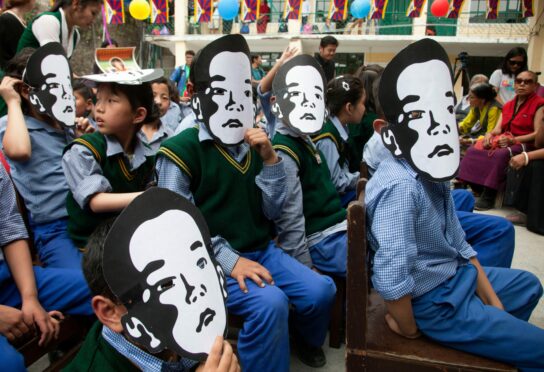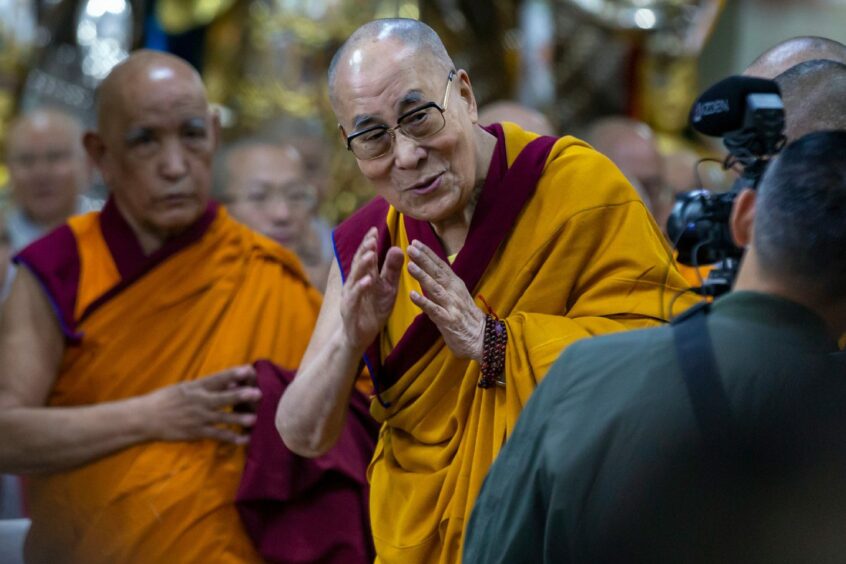
For Tibetans it was a sombre birthday celebration. The man they were honouring was turning 33, but exists only in a single, haunting photo of a rosy-cheeked six-year-old boy.
It is the sole evidence the Panchen Lama, Tibet’s second-most-important religious leader, ever existed.
Nobody knows where he spent his birthday, or if he is safe. Many fear he may no longer be alive. In May 1995, the child Gedhun Choekyi Nyima was declared the eleventh Panchen Lama by Tibet’s spiritual leader, the Dalai Lama. Within days, the boy and his parents were removed from their remote Tibetan home by Chinese security forces. They have not been heard from since.
Soon after his disappearance, government officials produced their own “Panchen Lama”, a boy the same age who, as an adult, is still paraded on special occasions. Tibetans ignore him. They know who their real Panchen Lama is. They just don’t know where he is.
Gedhun Choekyi Nyima is often referred to as the world’s youngest political prisoner. His value to his captors, and almost certainly the reason for the bizarre swap, is his traditional role in identifying the next Dalai Lama. The current Dalai Lama, 86 and living in exile in northern India, has remained an inspirational, unifying figure for Tibetans.
A China-appointed Dalai Lama would be an attempt to destabilise the 150,000-strong Tibetan diaspora, as well as tightening the Chinese Communist Party’s grip on the six million Tibetans living inside China.
For them, the missing Panchen Lama has become a symbol of their culture’s plight. He is the public face of a disappearing history and language – and now an entire generation of disappearing children.
In 2021, a report from US-based Tibet Action Institute revealed damning evidence of China’s massive network of compulsory colonial boarding schools inside Tibet.
The schools separate children as young as four from their parents and house 800,000 children.
The schools aim to remould children into loyal Chinese nationals by teaching them in Mandarin, banning their Buddhist faith, and subjecting them to political indoctrination, says Lhadon Tethong, Tibet Action Institute director.
“We believe 800,000 is a conservative estimate. There are likely to be many younger children also in these schools,” she says. “But even that number means 80% of all Tibetan children between the ages of six to 18 are in these identity elimination schools.”
She adds: “The psychological and emotional toll this will inflict is hard to comprehend. They have stolen an entire generation.”
Testimonies from former students contained in the report detail beatings, sexual harassment, filthy conditions and 14-hour days of lessons glorifying the Chinese communist party.
The report draws a grim conclusion: “While China has oppressed the Tibetan people for decades, it is now directly targeting Tibetan children as part of Xi Jinping’s masterplan to eliminate Tibetan language and identity once and for all.”
It’s hard to think of a measure that could inflict greater despair. Tibetans are extraordinarily resilient. Tibetan former political prisoners’ spirit remains undiminished by decades of incarceration and torture. But this attack on their youngest and most vulnerable is a heavy blow. “What we’re hearing is a serious, elevated level of sadness, anger and frustration,” says Tethong. “As one person put it, the walls are closing in on Tibetans from every side.”
Multiple measures are stifling all forms of protest or escape. For decades, thousands of Tibetans a year (at its height, an average of 2,200 according to Human Rights Watch) have braved the treacherous route to freedom across the Himalayas into India and Nepal. Those who survive devote themselves to preserving their culture and bearing witness to the human rights abuses in their homeland.
Women like Gyaltsen Pasang, who spent a year and eight months in Lhasa’s Gutsa Prison at 13 years old, for joining a nuns’ protest for religious freedom.
Now in exile, she remembers weekly beatings with electric cattle prods on her bare skin and how the three prongs always drew blood; the filthy two-metre-square cell she shared with eight other people.
How she was made to stand motionless on a high wall in freezing winds until she collapsed with exhaustion. How she managed not to cry – until she heard other children playing just outside the prison wall.
Lobsang Lungtok, now living in Australia, was “disappeared” the month after the Panchen Lama’s detention. Lungtok, 19 at the time, was seized by security forces at his village market after he’d written a poem in praise of Tibet. “There were so many of them, just for me,” he recalls. “I found out in prison they had taken the Panchen Lama. The prison guard said: ‘We have arrested your highest leader. If we can do that to him, what hope is there for a nobody like you? You are nothing.’”
None of Lungtok’s family knew his whereabouts. When he was released after 18 months, he heard the police were going to round up locals. This time, he fled to India.
Last December, his mother, still in Tibet, died. Lungtok hadn’t seen her for more than 12 years. Now an Australian citizen and desperate to see her, he tried last year to obtain a Chinese visitor’s visa. “My Australian passport was returned by the Chinese Embassy with large red Chinese writing on one page, with no explanation,” he says.
Such first-hand accounts from exiles have been an inconvenient truth for the Chinese government, undermining its claims that Tibetans are content under communist rule. In response, even the remotest sections of the borders have been saturated with patrols and drone surveillance to the extent that fewer than 20 Tibetans a year now escape.
Since the widespread protests across the region following the 2008 Beijing Olympics, it has been impossible for foreign media to gain access. It’s only outside Tibet that exiled Tibetans can tell their stories. Those inside are left with a stark choice: submit to assimilation, or accept the consequences.
There is also another way. The tragic, almost unthinkable act of self-immolation has been the final gesture of 159 Tibetans since 2009. The most recent sent shockwaves even through a Tibetan community accustomed to such horrors.
Tibetan pop star Tsewang Norbu was 25, an apparent poster boy for Chinese assimilation. His hit songs were non-controversial, he spoke fluent Mandarin, and had recently signed a contract with Warner Music China.
And then, on February 25 this year, he drove to Tibet’s most famous landmark, the Potala palace in Lhasa, poured kerosene on his body and set himself ablaze, shouting: “Free Tibet!”
While death by self-immolation can be hard to comprehend for outsiders, Tethong says Tibetans view it as a gesture of defiance, not defeat. “Tragic though it is, they are taking control of the one last thing they have. When the Chinese government is saying, ‘You will not speak, you are in our control’, this tells them, ‘No, I am not.’”
After 71 years of occupation, is there any genuine hope for Tibetan freedom?
It can be hard, Tibetans say, to witness the West’s strong stance against Russia’s invasion of Ukraine, while the world has repeatedly failed to intervene in their homeland’s occupation. But they also see hope in this new resistance to authoritarianism.
“What we take from this moment, besides our feeling of kinship, empathy and pain for what Ukrainians are enduring, is the world might at last understand the threat Russia under Putin and China under Xi Jinping pose to global peace and security,” says Tethong.
“And the greatest hope many Tibetans have, is this is a really transformative moment, and that the lessons and the new clarity about Putin can transfer over to China as well.”

Enjoy the convenience of having The Sunday Post delivered as a digital ePaper straight to your smartphone, tablet or computer.
Subscribe for only £5.49 a month and enjoy all the benefits of the printed paper as a digital replica.
Subscribe